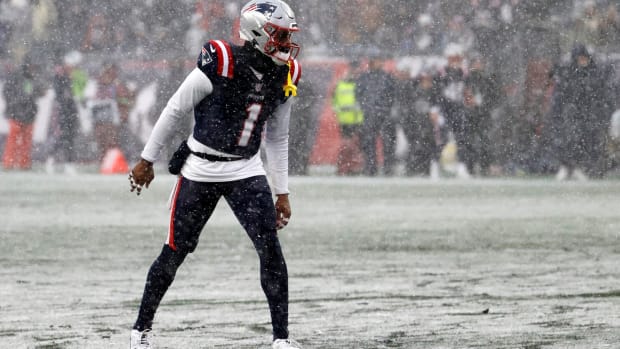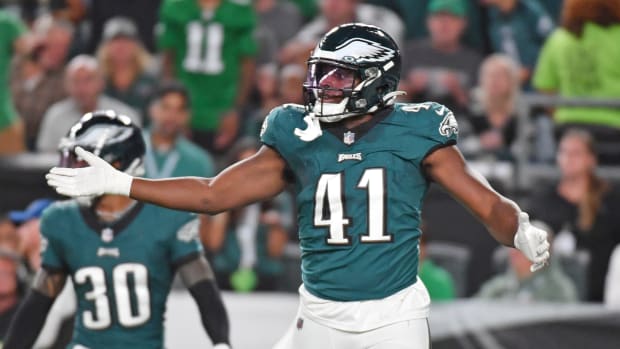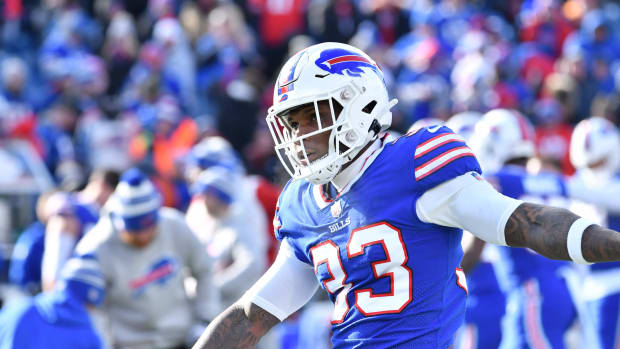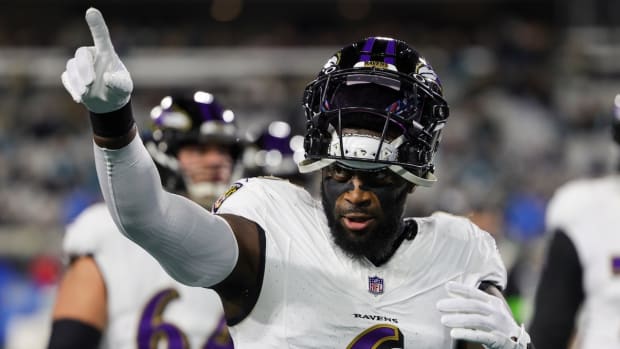
Broncos Preview: Even Better Than Before
After nine seasons in Dallas, DeMarcus Ware signed a rich free-agent deal to come chase quarterbacks for Denver. (Doug Pensinger/Getty Images)
Super Bowl 48 was an all-time butt-kicking comprised of a bunch of individual butt-kickings. No butt-kicking stood out more than the one Cliff Avril, Michael Bennett and the rest of the Seahawks defensive line put on Orlando Franklin. The Broncos’ right tackle played with the quickness and flexibility of a cigar store Indian. He was paramount in his team’s first unsuccessful third down, in the first interception, on the second interception (the one Malcolm Smith returned for a touchdown) and on a litany of other failed plays.
It was obvious that in order for the Broncos to have a good chance at avenging their face-plant this season, they’d have to make a change at right tackle. Not surprisingly, with Pro Bowler Ryan Clady’s return from a Lisfranc (foot) injury at left tackle, the placeholder on that side, Chris Clark, will now start at right tackle. He is not the long-term solution, as Broncos GM John Elway used a third-round pick on Michael Schofield. Whoever plays there, it won’t be Franklin. He’s moving to left guard, where he’ll replace the departed Zane Beadles and play opposite Pro Bowler Louis Vasquez, a very good man-blocker and pass protector. In between Franklin and Vasquez will be incumbent center Manny Ramirez, who fended off veteran pickup Will Montgomery.
Franklin was far from the only weakness that stood out in Super Bowl 48. Wideout Eric Decker absolutely could not shake press coverage. To the surprise of some—though no one who studied Broncos film week in and week out—Decker was allowed to walk in free agency. He signed a five-year, $36.25 million contract with the Jets and Elway brought in the superior Emmanuel Sanders for three years, $15 million. Sanders set a career-high with 740 yards receiving in Pittsburgh last year, which was 548 fewer than the career-high Decker set. But everyone for Denver posted career highs (or close to it) playing in what was the most prolific offense in NFL history. Sanders, with his multidirectional speed and quickness, poses a tougher matchup for defenses.
Picks Are In
Everything you want to know about the 2014 season—from who will be named MVP to who will win the Super Bowl—can be found in The MMQB's Predictions Extravaganza.
Running back Knowshon Moreno also was allowed to walk in free agency. He was Denver’s best backfield option last season, but that was only because second-round rookie Montee Ball did not grasp all of a Peyton Manning-and Adam Gase-led system that’s not immense in volume but
is
immense in nuances. Ball, with his solid short-area burst and patience as a slasher, is a better pure runner than Moreno. To stick in this offense, he must become a more refined pass protector and receiver. (Given Manning’s predilection for having all five receiving options available, the latter in many respects is more important than the former. Of course, pass blocking is harder to master and its mistakes are more damning.) With unreliable Ronnie Hillman and undrafted second-year pro C.J. Anderson as the only other running back options, it’s apparent the Broncos would not have let Moreno leave if they weren’t sure about Ball’s readiness.
Ball will have plenty of opportunities to run against a lighter box as defenses, fearing Manning, will often play two safeties deep. (The Seahawks didn’t, but they have uncommonly talented players.) Often defenses are left with no choice but to play two-high because of Denver’s lethal three-receiver base package. Sanders is the least threatening player of that bunch, which is saying something. The most threatening is Demaryius Thomas, who has burgeoned to the cusp of superstardom thanks to a combination of speed and strength. Thomas commands double-teams as an “X-iso” receiver on the weak side of Denver’s staple 3 x 1 sets. He’s a nightmarish one-on-one matchup when aligned inside on the strong side of those sets. And he’s equally as dangerous in 2 x 2 sets, where he’s featured regularly in what’s become the most potent wide receiver screen game in football.
And then there’s the other Thomas—Julius. While Manning’s Colts were known for their static formations and repetitious concepts, these Broncos are hallmarked by a bevy of different formations and personnel distribution. The uber-athletic fourth-year tight end and second-year starter is a big part of that. Gase has done a great job designing formations around Thomas’s versatility, often flexing the 6-5, 245-pound ex-basketball player out wide on the weak side to distort zone coverage assignments and put man-to-man defenders in unfamiliar locations. This season, Thomas is expected to be moved around even more. The only real concern with him is an ineptitude at in-line blocking.
Benefitting from mismatches created by the Thomases is Wes Welker, who if healthy (concussions have been a problem as of late), is still the league’s preeminent slot receiver thanks to his aptitude on option routes, shallow crosses and, more so in recent years, seam patterns. When Welker is off the field (which he'll be for the first four games, thanks to a suspension for amphetamines), usually a second tight end—either the steady Jacob Tamme or the less dependable but more diverse and athletic Virgil Green—will be in. Not much of the playbook becomes off-limits when Denver’s three-receiver system shifts to two tight ends.
DEFENSE
Even greater changes have been made to a defense that, despite a rash of injuries in the secondary and to the pass rush, actually played pretty well late last year, including in the loss to Seattle. Von Miller, who was suspended the first six games and then played with 15 added pounds to his original 255-pound frame, was out with a torn ACL during that stretch run. Now back and at his original weight, Miller’s presence alone can regenerate the pass rush.
After a monstrous first two seasons (30 sacks in 31 games), Von Miller came crashing back to reality in 2013 (five sacks in nine games). (Doug Pensinger/Getty Images)
Though just to be sure, Elway spent $20 million guaranteed in a three-year, $30 million deal for DeMarcus Ware. The ex-Cowboy is coming off the worst season of his future Hall of Fame career, where he battled a torn right quad, herniated disk and hyperextended elbow. Such a MASH-list for a 32-year-old raises a red flag, though Ware had never been significantly dinged prior to last season. If Elway’s bet on him pays off, the Broncos could have the most explosive pass-rushing tandem of all-time.
John Fox and defensive coordinator Jack Del Rio in recent years have expanded from their longtime 4-3 zone beliefs to infuse a variety of blitz concepts into their scheme. How much they stick with those concepts in 2014 will be largely determined by what they’re getting from Miller and Ware. They’ll have them line up on opposite edges, where offenses will have a tough time doubling both. But given Miller’s dominance as a movable, stand-up player (i.e. a “joker”), expect to see him roving around and attacking from the same side as Ware from time to time. These will be blitz looks, though many will turn out to be zone exchanges, with would-be pass rushers dropping back into coverage and an unpredictable group of four men rushing the passer.
A key component in these sub-package concepts will be defensive lineman Malik Jackson, who is agile in traffic. Last year’s first-round pick, Sylvester Williams, saw increased playing time late in his rookie year and also figures to factor here.
This reworked pass rush will work in conjunction with a secondary that has also had high-profile acquisitions. Much of the hype has centered around cornerback Aqib Talib. His press-man prowess perfectly fits a defense that last season played man-to-man almost exclusively. But the player Talib is replacing, Dominique Rodgers-Cromartie, also had an excellent 2013 campaign where he was rarely thrown at, even in one-on-one scenarios. Talib at his best is better than Rodgers-Cromartie at his best, but not by much.
And so the real improvements in this secondary will stem from safety, where T.J. Ward was Elway’s third huge defensive free agent signing. The ex-Brown stabilizes a position that was in flux last season and offers more dimension schematically. Ward is capable in space, though being a hard-hitting and firm tackler, he’s always been best in the box. His value escalated in recent years as he developed the man coverage skills to defend tight ends one-on-one, even when detached from the formation. That’s a huge variable this defense didn’t have before.
Ward carries a domino effect for the rest of Denver’s safeties. Rahim Moore, hoping to come back from a devastating leg injury, can stay in centerfield the whole time, which gives him a better chance at leveling his ups and downs.
With the release of Duke Ihenacho, it’s unlikely the Broncos plan on frequently using their dime package this season, which means they need two linebackers who can cover in nickel. On this note, it was surprising that Wesley Woodyard was not retained. The only proven pass defending backer on the roster is now Danny Trevathan, who has excellent movement skills and is developing more awareness. The 2012 sixth-round pick will be an every-down player, joining Nate Irving in the base scheme.
Fox and Del Rio ask a lot of their second-level run defenders, making Irving’s lack of experience a little concerning. But at least the three-year backup will have a solid cast around him, assuming high energy end/tackle Derek Wolfe is back to 100 percent. Wolfe suffered a spinal cord injury in the 2013 preseason, and tried to return to action too soon, compromising parts of his nervous system, leading to terrifying seizures. Joining a healthy Wolfe up front is nose tackle Terrance Knighton, who has a superb first step.
CAMP EPICENTER
Get team-by-team previews and camp reports, along with other features and analysis from The MMQB's writers, in the 2014 Training Camp Hub.
Winning on the ground is important, but after injuries ravaged this secondary in 2013, winning in the air has become the primary concern in Denver. The return of Miller and acquisitions of Ware, Talib and Ward will mean little if there are exploitable weaknesses at cornerback. First-round rookie Bradley Roby will be closely watched playing opposite Talib. So will Chris Harris, a rising slot man who is coming off a January ACL tear. If depth here again becomes a factor, 2013 third-round pick Kayvon Webster, who has played exclusively on the outside, will be the next man up.
SPECIAL TEAMS
Matt Prater (who is suspended the first four games this season under the substance abuse policy) only missed one field goal last season, and it was from 52 yards. Not that he’s incapable of kicking from that distance. In the thin Mile High air in Week 14 he made an NFL-record 64-yarder. Punter Britton Colquitt is average but won’t have to be used often. Return duties will likely go to Andre Caldwell on kicks and Wes Welker on punts.
BOTTOM LINE
It’s a more talented Broncos team than last year. But no team since the 1972 Dolphins has won a Super Bowl the year after losing it. That, of course, is technically irrelevant to this Broncos club, but it’s hard to ignore a 42-year-old trend.







































